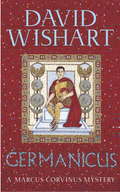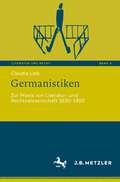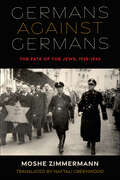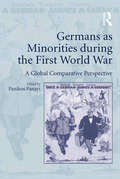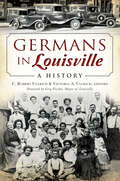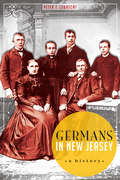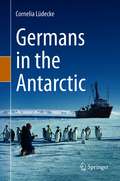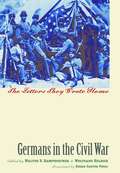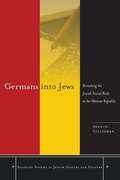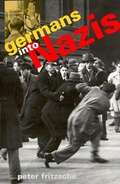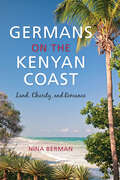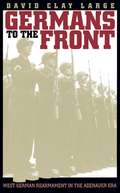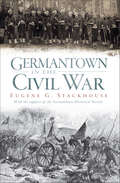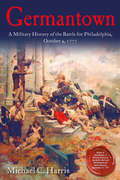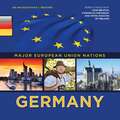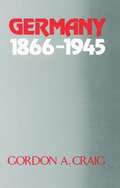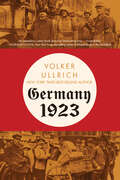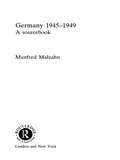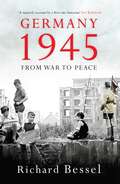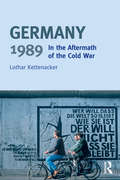- Table View
- List View
Germanicus
by David WishartMarcus Corvinus feels his heart sink when he is summoned by Empress Livia. Age has not sweetened her and she's about as trustworthy as a snake with a migraine. But Livia has a way of asking a favour that is impossible to refuse - which is how Marcus finds himself investigating the death of her grandson, Germanicus. And uncovering a multi-stranded web of betrayal and deceit that threatens the imperial succession and even Emperor Tiberius himself.
Germanicus: The Magnificent Life and Mysterious Death of Rome's Most Popular General
by Lindsay Powell&“The story of a Roman Emperor that might have been&” (Fighting Times). Germanicus was regarded by many Romans as a hero in the mold of Alexander the Great. His untimely death, in suspicious circumstances, ended the possibility of a return to a more open republic. This, the first modern biography of Germanicus, is in parts a growing-up story, a history of war, a tale of political intrigue, and a murder mystery. In this highly readable, fast paced account, historical detective Lindsay Powell details Germanicus&’s campaigns and battles in Illyricum and Germania; tracks him on his epic tour of the Eastern Mediterranean to Armenia and down the Nile; evaluates the possible causes of his death; and reports on the cruel fate his wife, Agrippina, and their children suffered at the hands of Praetorian Guard commander, and Tiberius&’s infamous deputy, Aelius Sejanus.
Germanistiken: Zur Praxis von Literatur- und Rechtswissenschaft 1630‒1900 (Literatur und Recht #4)
by Claudia LiebHaben die germanischen Götter die Poesie und das Recht erfunden? Kann man einen Text rekonstruieren wie eine Tat? Sind Juristen oder Philologen die besseren Leser? Ist der Wissenschaftler so genial wie der Dichter? ‒ Vor rund 400 Jahren befasste sich eine gelehrte Denkgemeinschaft mit deutschen Texten aus Literatur und Recht. Vor fast 300 Jahren wurden die Spezialisten des deutschen Rechts „Germanisten“ genannt und bald auch die Experten deutscher Literatur. Claudia Liebs Analyse der gemeinsamen Vorgeschichte von Literatur- und Rechtswissenschaft beschreibt erstmals die historischen Verflechtungen von philologischer und juristischer Germanistik.
Germans against Germans: The Fate of the Jews, 1938–1945 (Olamot Series in Humanities and Social Sciences)
by Moshe ZimmermannAmong the many narratives about the atrocities committed against Jews in the Holocaust, the story about the Jews who lived in the eye of the storm—the German Jews—has received little attention. Germans against Germans: The Fate of the Jews, 1938–1945, tells this story—how Germans declared war against other Germans, that is, against German Jews. Author Moshe Zimmermann explores questions of what made such a war possible? How could such a radical process of exclusion take place in a highly civilized, modern society? What were the societal mechanisms that paved the way for legal discrimination, isolation, deportation, and eventual extermination of the individuals who were previously part and parcel of German society? Germans against Germans demonstrates how the combination of antisemitism, racism, bureaucracy, cynicism, and imposed collaboration culminated in "the final solution."
Germans as Minorities during the First World War: A Global Comparative Perspective
by Panikos PanayiOffering a global comparative perspective on the relationship between German minorities and the majority populations amongst which they found themselves during the First World War, this collection addresses how ’public opinion’ (the press, parliament and ordinary citizens) reacted towards Germans in their midst. The volume uses the experience of Germans to explore whether the War can be regarded as a turning point in the mistreatment of minorities, one that would lead to worse manifestations of racism, nationalism and xenophobia later in the twentieth century.
Germans in Louisville: A History (American Heritage Ser.)
by C. Robert Ullrich and Victoria A. UllrichDiscover the German influence on the Derby City in this collection of historical essays. The first German immigrants arrived in Louisville nearly two hundred years ago. By 1850, they represented nearly twenty percent of the population, and they influenced every aspect of daily life, from politics to fine art. In 1861, Moses Levy opened the famed Levy Brothers department store. Kunz&’s &“The Dutchman&” Restaurant was established as a wholesale liquor establishment in 1892 and then became a delicatessen and, finally, a restaurant in 1941. Carl Christian Brenner, an emigrant from Lauterecken, Bavaria, gained notoriety as the most important Kentucky landscape artist of the nineteenth century. C. Robert and Victoria A. Ullrich edit a collection of historical essays about German immigrants and their fascinating past in the Derby City.
Germans in New Jersey: A History (American Heritage)
by Peter T. LubrechtGerman immigrants and their descendants are integral to New Jersey's history. When the state was young, they founded villages that are now well-established communities, such as Long Valley. Many German immigrants were lured by the freedom and opportunity in the Garden State, especially in the nineteenth century, as they escaped oppression and revolution. German heroes have played a patriotic part in the state's growth and include scholars, artists, war heroes and industrialists, such as John Roebling, the builder of the Brooklyn Bridge, and Thomas Nast, the father of the American cartoon. Despite these contributions, life in America was not always easy; they faced discrimination, especially during the world wars. But in the postwar era, refugees and German Americans alike--through their Deutsche clubs, festivals, societies and language schools--are a huge part of New Jersey's rich cultural tapestry.
Germans in the Antarctic
by Cornelia LüdeckeWhile science was usually at the forefront of German Antarctic expeditions, research into the Southern Polar region always had a political or economic component, whether it was about resource use or securing areas of influence.Cornelia Lüdecke presents the course of the three German Antarctic expeditions from 1901-03, 1911-12 and 1938/39 with their partly dramatic turns and twists and provides insights into everyday life under extreme conditions.She also evaluates unpublished material from the archives and private estates of the expedition members. She looks at the expeditions from a scientific and political point of view and also deals with the myths associated with the "Schwabenland" expedition during the National Socialist era.Finally, the author describes German south polar research after World War II, which took different paths in the German Democratic Republic and in the Federal Republic of Germany, and gives an outlook on future research. For the first time, this book presents the history of the Germans in Antarctica in a factual and informative way for the general public. With numerous pictures, some of which have never been published before.
Germans in the Civil War
by Walter D. Kamphoefner Wolfgang HelbichGerman Americans were one of the largest immigrant groups in the Civil War era, and they comprised nearly 10 percent of all Union troops. Yet little attention has been paid to their daily lives--both on the battlefield and on the home front--during the war. This collection of letters, written by German immigrants to friends and family back home, provides a new angle to our understanding of the Civil War experience and challenges some long-held assumptions about the immigrant experience at this time. Originally published in Germany in 2002, this collection contains more than three hundred letters written by seventy-eight German immigrants--men and women, soldiers and civilians, from the North and South. Their missives tell of battles and boredom, privation and profiteering, motives for enlistment and desertion and for avoiding involvement altogether. Although written by people with a variety of backgrounds, these letters describe the conflict from a distinctly German standpoint, the editors argue, casting doubt on the claim that the Civil War was the great melting pot that eradicated ethnic antagonisms.
Germans into Jews
by Sharon GillermanThe demographic and social disruptions wrought by World War I catapulted vague 19th-century fears about biological and cultural survival into what many described as an acute crisis, explains Gillerman (Jewish history, Hebrew Union College-Jewish Institute of Religion, Los Angeles). The concerns affected many groups across Europe, but she focuses on the Jewish community in defeated Germany, tracing how Jewish social workers, physicians, lay people and religious leaders transformed the postwar crisis into an opportunity for Jewish revitalization. Within the framework of a general debate on gender roles, reproduction, work, and the family, she says, reformers repositioned the bodies of biologically and economically unproductive Jews from the margins of Jewish society to the center of a project to rejuvenate German Jewry. Annotation c2010 Book News, Inc. , Portland, OR (booknews. com)
Germans into Nazis
by Peter FritzscheIn this dramatically plotted book, organized around crucial turning points in 1914, 1918, and 1933, Peter Fritzsche explains why the Nazis were so popular and what was behind the political choice made by the German people.
Germans on the Kenyan Coast: Land, Charity, and Romance
by Nina Berman“Shed[s] light on the romantic, psychosexual and psychosocial, and economic entanglements that tie German tourists to their Kenyan hosts.” —Daily NationDiani, a coastal town on the Indian Ocean, is significantly defined by a large European presence that has spurred economic development and is also supported by close relationships between Kenyans and European immigrants and tourists. Nina Berman looks carefully at the repercussions that these economic and social interactions have brought to life on the Kenyan coast. She explores what happens when poorer and less powerful members of a community are forced to give way to profit-based real estate development, what it means when most of Diani’s schools and water resources are supplied by funds from immigrants, and what the impact of mixed marriages is on notions of kinship and belonging as well as the economy. This unique story about a small Kenyan town also recounts a wider tale of opportunity, oppression, resilience, exploitation, domination, and accommodation in a world of economic, political, and social change.“In this richly detailed book, Nina Berman tracks the influx of thousands of German-speaking tourists and residents, especially in the 1990s, and the making of a distinctive Kenyan-European cultural enclave in the coastal community of Diani as many of these visitors choose to extend their stay as long-term residents.” —Ann Biersteker, author of Masomo ya Kisasa: Contemporary Readings in Swahili“An informative and thought-provoking work that deserves to be read by scholars of Kenya and those interested in globalized structures of gentrification, north-south humanitarian assistance, and love and romance in Africa.” —African Studies Quarterly
Germans to Poles
by Hugo ServiceAt the end of the Second World War, mass forced migration and population movement accompanied the collapse of Nazi Germany's occupation and the start of Soviet domination in East-Central Europe. Hugo Service examines the experience of Poland's new territories, exploring the Polish Communist attempt to 'cleanse' these territories in line with a nationalist vision, against the legacy of brutal wartime occupations of Central and Eastern Europe by Nazi Germany and the Soviet Union. The expulsion of over three million Germans was intertwined with the arrival of millions of Polish settlers. Around one million German citizens were categorised as 'native Poles' and urged to adopt a Polish national identity. The most visible traces of German culture were erased. Jewish Holocaust survivors arrived and, for the most part, soon left again. Drawing on two case studies, the book exposes how these events varied by region and locality.
Germans to the Front
by David Clay LargeIn Germans to the Front, David Large charts the path from Germany's total demilitarization immediately after World War II to the appearance of the Bundeswehr, the West German army, in 1956. The book is the first comprehensive study in English of West German rearmament during this critical period. Large's analysis of the complex interplay between the diplomatic and domestic facets of the rearmament debate illuminates key elements in the development of the Cold War and in Germany's ongoing difficulty in formulating a role for itself on the international scene.Rearmament severely tested West Germany's new parliamentary institutions, dramatically defined emerging power relationships in German politics, and posed a crucial challenge for the NATO alliance. Although the establishment of the Bundeswehr ultimately helped stabilize the nation, the acrimony surrounding its formation generated deep divisions in German society that persisted long after the army took the field. According to Large, the conflict was so bitter because rearmament forced a confrontation with fundamental questions of national identity and demanded a painful reckoning with the past.
Germantown in the Civil War (Civil War Series)
by Eugene G. StackhouseWhen the first shots of the Civil War were fired, nearly one-third of Germantown's sons and daughters answered the call to duty. Generals and soldiers, doctors and nurses all fought to preserve the Union. Many were lost, but some returned home to carry on the memory of their fallen comrades through the efforts of the Grand Army of the Republic. The Philadelphia neighborhood was itself transformed when the town hall became Cuyler Hospital and local nurses like Catherine Keyser and Hannah Zell cared for the wounded of Gettysburg and other battles. In this intimate and sharply focused account, local historian Eugene Glenn Stackhouse commemorates the sacrifices of Germantown's proud citizenry.
Germantown: A Military History of the Battle for Philadelphia, October 4, 1777
by Michael C. HarrisThe award–winning author of Brandywine examines a pivotal but overlooked battle of the American Revolution’s Philadelphia Campaign.Today, Germantown is a busy Philadelphia neighborhood. On October 4, 1777, it was a small village on the outskirts of the colonial capital—and the site of one of the American Revolution’s largest battles. Now Michael C. Harris sheds new light on this important action with a captivating historical study.After defeating Washington’s rebel army in the Battle of Brandywine, General Sir William Howe took Philadelphia. But Washington soon returned, launching a surprise attack on the British garrison at Germantown. The recapture of the colonial capital seemed within Washington’s grasp until poor decisions by the American high command led to a clear British victory. With original archival research and a deep knowledge of the terrain, Harris merges the strategic, political, and tactical history of this complex operation into a single compelling account. Complete with original maps, illustrations, and modern photos, and told largely through the words of those who fought there, Germantown is a major contribution to American Revolutionary studies.
Germany (Major European Union Nations)
by Ida WalkerEver since Germany formed in 1871, it has been a major world player. It was even a founding member of the EU in 1952. Although Germany's 20th-century history was often dark, it is now one of the most prosperous and stable countries in the world. It has struggled during the global recession, but it has also been a leader in facing the EU's economic difficulties. Discover more about this exciting, modern nation!
Germany - The Tides of Power: The Tides Of Power
by Michael BalfourIn Germany - The Tides of Power, Michael Balfour sets out to explain the factors which have shaped the German social, political and economic character. Tracing the movement of power from the Middle Ages onwards, he seeks to lead the reader to an understanding of modern Germany - why Germany precipitated, and lost, two major wars this century; how the astonishing growth of wealth over the last half-century was achieved; the meaning behind the recent unification of Germany. As German economic expansion continues into the 1990's, Professor Balfour discusses the power held by this technologically advanced nation - and considers the acceptance of this power by the rest of the world.
Germany 1789-1919: A Political History (Routledge Library Editions: German History #35)
by Agatha RammOriginally published in 1967, this book discusses economic and constitutional developments and religious history in relation to their political consequences. Political theory is treated in two sections: one is devoted to the ideas current from 1789 to the ‘revolutionary year’ of 1848, and another to those of the Bismarckian era. The author used archival material to verify her analysis of such complicated questions as the operation of the Holy Roman Empire and Bismarckian foreign policy. Investigating the disappearance of the old Germany, in which medieval institutions still survived the book shows that the unification of Germany was not the final climax of German history, it appeared, at the time, to be.
Germany 1866-1945 (Oxford History of Modern Europe)
by Gordon A. CraigA history of the rise and fall of united Germany, which lasted only 75 years from its establishment by Bismark in 1870. Suitable for A Level and upwards. In the OXFORD HISTORY OF MODERN EUROPE series.
Germany 1923: Hyperinflation, Hitler's Putsch, And Democracy In Crisis
by Volker UllrichFrom the New York Times best-selling historian comes a gripping account of the crisis of the Weimar Republic, when hyperinflation and political upheaval threatened to unravel a new experiment in democracy. As the great Austrian writer Stefan Zweig confided in his autobiography, written in exile, “I have a pretty thorough knowledge of history, but never, to my recollection, has it produced such madness in such gigantic proportions.” He was referring to the situation in Germany in 1923. It was a “year of lunacy,” defined by hyperinflation, a political system on the verge of collapse, and separatist movements that threatened Germany’s territorial integrity. Most significantly, Adolf Hitler launched his infamous Beer Hall Putsch in Munich—a failed coup that nonetheless drew international attention and demonstrated the Nazis’ ruthless determination to seize power. In Germany 1923, award-winning historian Volker Ullrich draws on letters, memoirs, newspaper articles, and other sources from the time to present a captivating new history of those explosive twelve months. The crisis began when the French invaded the Ruhr Valley in January to force Germany to pay the reparations it owed under the Treaty of Versailles, which had ended the Great War. For years, German leaders had embraced inflationary policies to finance the costs of defeat, and, as Ullrich demonstrates, the invasion utterly destroyed the value of the German mark. Before the war, the exchange rate was 4.2 marks to the dollar. By November 20, 1923, a dollar was worth an incomprehensible 4.2 trillion marks, and a loaf of bread cost 200 billion. Facing the abyss, many ordinary Germans called for a national messiah. Among the figures to vie for that role was Hitler, a thirty-four-year-old veteran who possessed a uniquely malevolent personal magnetism. Although the Nazi coup in November was put down and Hitler arrested, the putsch showed just how tenuous the first German democracy, the Weimar Republic, was at its core. As Ullrich’s panoramic narrative reveals, other Germans responded to the successive crises by launching a cultural revolution: 1923 witnessed the emergence of a multitude of new movements, from Dada to Bauhaus, and of such iconoclasts as Bertolt Brecht, George Grosz, and Franz Kafka. Yet most observers were amazed that the Weimar Republic was able to survive, and the more astute realized that the feral undercurrents unleashed could lead to much worse. Publishing a century after that fateful year, Germany 1923 is a riveting chronicle of one of the most challenging times any modern democracy has faced, one with haunting parallels to our own political moment.
Germany 1945-1949: A Sourcebook
by Manfred MalzahnThe period 1945-1949 is generally acknowledged as a critical period for the German people and their collective history. But it did not, Manfred Malzahn argues, lead inevitably to the construction of the Berlin Wall. As in 1989, so in 1945 the German people were prepared to break away from established patterns, to reassess, if need be, what it meant to be German. Then, as now, Germans East and West wanted order and stability; food, shelter, clothing and work. Using numerous documents from the immediate post-war years, Malzahn rescues the period from the burden of selective hindsight and nostalgia that has obscured the contemporary situation. The documents, which have been fully annotated, reflect life at all levels from politics to fashion, and contain both Allied and German viewpoints. They are bound together by an emphasis on communication, on Allied/German interaction, and on the Germans' dialogue with their past and expressions of their aspirations.
Germany 1945: From War to Peace
by Richard BesselBessel (history, U. of New York) chronicles Germany's transition from aggressive superpower to an occupied territory with severely damaged infrastructure, a collapsed economy, and millions of its citizens homeless, in this history of the final months of World War II. The work, which is organized into thirteen chapters, examines the fall of the Third Reich, the loss of the German East, the beginnings of occupation, the quest for post-war stability, visions for Germany's future, and German perceptions of victimhood. Maps of German-occupied Europe in January 1945, the Soviet offensive of January 1945, and the final campaign from April-May 1945 are provided along with several black and white photographs. The volume is highly readable and well sourced with ninety-one pages of reference notes. Undergraduates and general readers interested in the history of World War II and issues of post-war transition will appreciate this work. Annotation ©2010 Book News, Inc. , Portland, OR (booknews. com)
Germany 1945: Views of War and Violence
by Dagmar Barnouw&“Packed with carefully chosen photos . . . this book is a moving reminder of the material and moral devastation left behind by Nazi Germany.&” ―Rudy Koshar, University of Wisconsin–Madison The Allied forces that entered Germany at the close of World War II were looking for remorse and open admissions of guilt from the Germans. Instead, they saw arrogance, servility, and a population thoroughly brainwashed by Nazis. But photos from the period tell a more complex story. In fact, Dagmar Barnouw argues that postwar Allied and German photography holds many possible clues for understanding the recent German past. A significant addition to the scholarship on postwar German culture and political identity, this book makes an important contribution to the current discussion of German memory. &“Provocative, brilliant, and unsettling.&” —Washington Times &“[Barnouw&’s] thoughtful analysis of a large assortment of photographs . . . allows Barnouw to look at how and not just what people saw, and to bring that perspective into conversation with the historical debates about the war&’s end in Germany.&” —Journal of Contemporary History) &“[Barnouw&’s] work shows that perspective plays a key role both in photography and in trying to master Germany&’s past. [F]ascinating.&” —Library Journal
Germany 1989: In the Aftermath of the Cold War (Turning Points)
by Lothar KettenackerIn autumn 1989 the world watched transfixed as East German citizens, demonstrating under the banner ‘We are the people!’, staged the only successful, totally peaceful revolution in German history. By October 1990, the process of reunification was formally concluded, bringing together a nation that had been divided for almost four decades. Now, nearly twenty years later, it is possible to judge the causes and consequences of the revolution more clearly. Was the fall of the Berlin Wall an unexpected fluke, or was it, in fact, the result of a long process of engagement between East and West? And did the momentous events of 1989 really signal the start of a bright new future for a united Germany? In this probing and wide-ranging account, Lothar Kettenacker considers the background behind the division of Germany and explains how the Berlin Wall and its death trap border proved to be the most horrendous manifestation of East-West antagonism. He also looks beyond 1990 to show how the confusion caused by the sudden collapse of the GDR and the fusion of two radically different economies is proving to be a challenge that will preoccupy Germany for generations to come.
